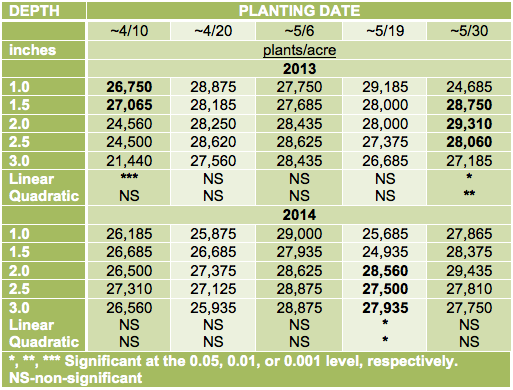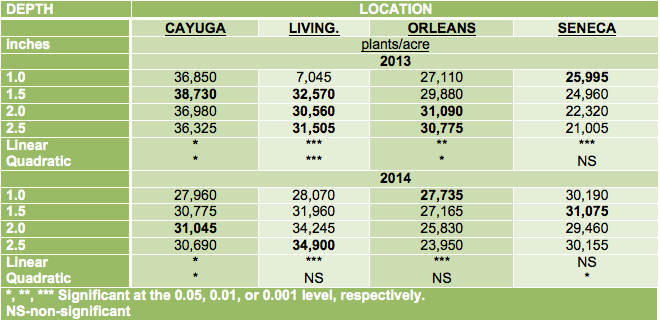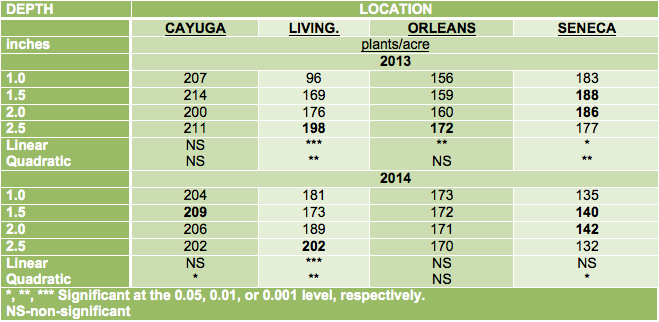Bill Cox, School of Integrative Plant Science, Soil and Crop Sciences Section and Phil Atkins, New York Seed Improvement Program, Cornell University
The average corn planting date is considerably earlier now compared to 25 years ago, especially in the Midwest USA. In NY, planting is earlier than ever but still lags behind most upper Midwest states. Certainly, the soils in the upper Midwest States are as cold as New York in late April or early May. Consequently, the slower planting pace in New York must be attributed to either wetter soils; lack of readiness, especially for dairy producers; previous negative experiences by growers with April planting dates; or lack of belief that the newer hybrids with seed treatments can be planted into somewhat cold April soils.
Most growers plant their corn at the “one size fits all” depth of 2-inches. Early-planted corn (~mid-April), however, can take 3 to 4 weeks to get out of the ground and a shallower planting depth may be beneficial for April planting dates. When planting is delayed until late May, as in 2011 and 2014, growers in NY wonder if they should switch to an earlier maturing hybrid. We conducted small-plot research at the Aurora Research Farm in 2013 and 2014 to answer three questions concerning corn planting: 1) Can corn be safely planted in early to late April on well-drained soils in NY without risk of poor stands and subsequent yield loss, 2) when should grain growers switch from a full-season to a shorter season hybrid, if planting is delayed, and 3) is the 2-inch seeding depth optimum from early April through late May planting dates?
We planted 103-day (203-44STXRIB from Channel) relative maturity (RM) and a 96-day (DKC46-20VT3P RIB from DeKalb) RM hybrids on ~April 10, ~April 20, ~May 6, ~May 19, and ~May 30 at 1.0, 1.5, 2.0, 2.5, and 3.0 inch seeding depths at a rate of 31,800 seeds/acre in 2013 and 2014. We determined stand establishment at ~ the 4th leaf stage (V4), about 3-6 weeks after planting, depending upon planting date. We harvested all plots on October 27th in 2013 and on November 5th in 2014.
Plant populations had a significant year x planting date x seeding depth interaction (Table 1). On most planting dates in both years, seeding depth did not affect plant populations (Table 1). In 2013, however, plant populations at the early April planting date had a negative linear response to seeding depths (~27,000 plants/acre at the 1.0 and 1.5 inch planting depths, ~24,500 plants/acre at the 2.0 and 2.5 inch planting depths, and only 21,500 plants/acre at the 3.0 inch depth). Presumably, the deeper-planted corn struggled to emerge because of cool conditions, accompanied by some soil crusting. Plant populations at the late May planting date in 2013, however, had a quadratic response (fewer than 25,000 plants/acre at the 1.0 inch planting depth, ~28,000-29,000 plants/acre from the 1.5 to 2.5 inch depths, before decreasing to ~27,000 plants/acre at the 3.0 inch depth). Presumably, soil conditions dried out in the top 1-inch depth resulting in poor emergence. Likewise, in 2014, there was an extended dry period shortly before and after planting on May 19th resulting in fewer than 26,000 plants/acre at the 1.0 and 1.5 inch seeding depths. Nevertheless, the 1.5 and 2.0 inch planting depths resulted in the most consistent stand establishment across all planting dates in both years of this study.

Although grain yield had no planting date x seeding depth interaction (P=0.06), the early April planting date did show a quadratic response to seeding depth with the 1.5 inch depth yielding 211 bushels/acre compared to only 189 bushels/acre for the 3.0 inch seeding depth (Table 2). On all the other planting dates, however, grain yield did not respond to seeding depth. Apparently, corn with its hygroscopic kernel can emerge adequately from a shallow depth in dry soil conditions, and with its coleoptile (seed leaf, first to emerge through the soil) can emerge adequately through crusted soils.

Grain yield showed a quadratic response to planting dates with the regression equation indicating that maximum yield occurred sometime between May 15 and May 20 (Table 2). This was somewhat later than expected. We expected that maximum yields would occur sometime between April 20 and May 20, especially because plant populations showed a quadratic response to planting dates with the numerically highest populations at the May 6 planting date (~28,525 plants/acre compared with 27,450 plants/acre for April 20 and 27,385 plants/acre for the May 19 planting date, averaged across years, hybrids, and planting depths). Consequently, it is not clear why maximum yield occurred from ~ May 15-20 rather than the ~May 5- 20 planting date range.
The 103 day hybrid yielded ~5% higher (220 bushels/acre) than the 96-day hybrid (209 bushels/acre), when averaged across years, planting dates, and seeding depths. Surprisingly, there was no hybrid x planting date interaction, which indicates that the longer-season hybrid will yield more than the shorter-season hybrid when planted from early April through late May in the Finger Lakes Region of NY. On the May 19th planting date, however, grain yield averaged only 3% greater (228 bushels/acre for the 103-day compared to 221 bushels/acre for 96-day hybrid) with significantly higher grain moisture (23.5 vs.19.3%, respectively). On the May 30th planting date, grain yield averaged ~4% greater (218 bushels/acre for the 103-day compared with 210 bushels/acre for the 96 day hybrid) but with much higher grain moisture (29.8% vs. 23.5% moisture, respectively). Given the much greater drying costs or much greater delay in harvest for the 103 day hybrid to dry down when planted in late May, NY growers should probably consider switching from a full-season to a medium-season hybrid shortly after May 20.
CONCLUSION
The reluctance of many corn growers in NY to plant corn in April may serve them well as indicated by maximum yields occurring sometime between May 15 and May 20 in this study. Growers, however, cannot plant their corn crop between May 15 and May 20 each year so the question remains “how early should growers begin to plant corn NY”? Although yields were 5% lower at the April 20 planting date (213 bushels/acre) vs. the May 19 planting date (224 bushels/acre), plant populations were similar and grain moistures were lower (17.5% vs. 21.4%, respectively). Consequently, relative profit would be essentially the same (assuming $4.00/bushel corn and $0.04/point of moisture drying costs) between these two planting dates. If growers are reluctant to start as early as late April, certainly the first week of May is an excellent time given the higher plant populations (28,525 plants/acre) compared with the May 19 planting date (27,385 plants/acre), lower grain moisture (18.7% vs. 21.4%, respectively), albeit 3% lower yields (217 bushels/acre vs. 224 bushels/acre). Nevertheless, relative profit would be similar for the two planting dates, given the assumptions of $4.00 corn and $0.04/bushel/point drying costs.
Regardless, if growers begin planting in late April or early May, corn growers in NY should probably plant full-season hybrids until around May 20 because of the yield advantage (6.3% on April 20, 5.4% on May 6, and 3.0% on May 20). Grain moisture differences, however, widen at each successive planting date (17.9 vs. 17.1% for April 20, 19.8% vs. 17.7% for May 6, and 23.5% vs. 19.3% grain moisture for May 19, respectively) so beyond May 20 the higher grain drying costs would offset the yield advantage or require a delay in harvest, which could lead to more in-field losses of the full-season hybrid before harvest. Consequently, a switch to shorter-season hybrids after May 20 is probably the most economical and risk-averse management strategy.
Planting at the 1.5 inch to 2.0 inch depths consistently resulted in the highest plant populations and grain yields among seeding depths across all planting dates. The 2.0 inch planting depth had less than 80% emergence (~25,000 plants/acre) only on the April 10 planting date in 2013 and the 1.5 inch planting depth had less than 80% emergence only on the May 19 planting date in 2014. Planting depth did not affect yield, however, (except for the April 10 planting date) but the 1.5 to 2.0 inch depth looks optimum across most planting dates in this study. Keep in mind that this study was conducted on a well-drained silt loam soil in the Finger Lakes Region and does not apply to poorly drained clay soils or regions of the state where late spring frosts or early fall frosts occur.


